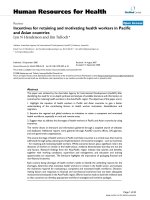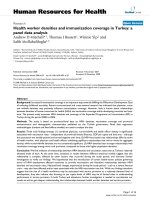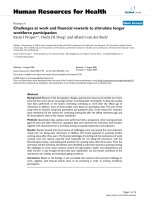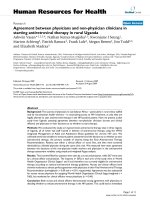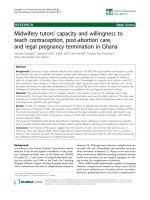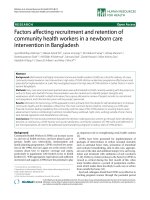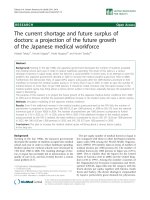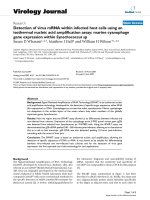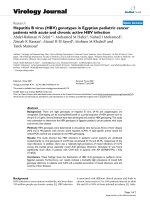Báo cáo sinh học: " Hepatitis B virus and hepatitis C virus in pregnant Sudanese women" pot
Bạn đang xem bản rút gọn của tài liệu. Xem và tải ngay bản đầy đủ của tài liệu tại đây (217.19 KB, 3 trang )
BioMed Central
Page 1 of 3
(page number not for citation purposes)
Virology Journal
Open Access
Research
Hepatitis B virus and hepatitis C virus in pregnant Sudanese women
Rasha M Elsheikh
1
, Ahmed A Daak
1
, Mohamed A Elsheikh
1
,
Mubarak S Karsany
2
and Ishag Adam*
1
Address:
1
Department of Obstetrics & Gynecology, Faculty of Medicine, University of Khartoum, Khartoum, Sudan and
2
Department of Pathology,
Faculty of Medicine, Juba University, Khartoum, Sudan
Email: Rasha M Elsheikh - ; Ahmed A Daak - ;
Mohamed A Elsheikh - ; Mubarak S Karsany - ; Ishag Adam* -
* Corresponding author
Abstract
Background: The epidemiology of viral hepatitis during pregnancy is essential for health planners
and programme managers. While much data exist concerning viral hepatitis during pregnancy in
many African countries, no proper published data are available in Sudan.
Aim: The study aimed to investigate the sero-prevalance and the possible risk factors for hepatitis
B virus (HBV) and hepatitis C virus (HCV) among antenatal care attendants in central Sudan.
Methods: During 3 months from March–June 2006, sera were collected from pregnant women at
Umdurman Maternity Hospital in Sudan, and they were tested for markers of hepatitis B virus
(HBVsAg) and HCV.
Results: HBVsAg was detected in 41 (5.6%) out 728 women, Anti-HCV was detected in 3 (0.6%)
out of 423 women, all of them were not aware of their condition. Age, parity, gestational age,
residence, history of blood transfusion, dental manipulations, tattooing and circumcision did not
contribute significantly to increased HBVsAg sero-positivity.
Conclusion: Thus 5.6% of pregnant women were positive for HBVsAg irrespective of their age,
parity and socio-demographic characteristics. There was low prevalence of Anti-HCV.
Introduction
Hepatitis B virus (HBV) infection affects over 350 million
people worldwide and over one million die annually of
HBV-related chronic liver disease. In endemic areas, most
individuals are infected by vertical transmission, or in the
early childhood [1]. Hepatitis C virus (HCV) infection is a
major worldwide public health problem. The World
Health Organization (WHO) estimates that 3% of the
world's populations are chronically infected with HCV,
most of these cases occur in Africa, which is reported to
have the highest HCV prevalence rate [2,3]. Although,
direct percutaneous inoculation is the most efficient
mode of transmission of HCV, several studies have dem-
onstrated that sexual, household, occupational, and verti-
cal transmission of HCV may also be of importance [4].
Viral hepatitis during pregnancy is associated with high
risk of maternal complications, has a high rate of vertical
transmission causing fetal and neonatal hepatitis and it
has been reported as a leading cause of maternal mortality
in Sudan [5-8]. The basic epidemiological data for these
viruses might be of great importance to the programme
Published: 24 October 2007
Virology Journal 2007, 4:104 doi:10.1186/1743-422X-4-104
Received: 9 August 2007
Accepted: 24 October 2007
This article is available from: />© 2007 Elsheikh et al; licensee BioMed Central Ltd.
This is an Open Access article distributed under the terms of the Creative Commons Attribution License ( />),
which permits unrestricted use, distribution, and reproduction in any medium, provided the original work is properly cited.
Virology Journal 2007, 4:104 />Page 2 of 3
(page number not for citation purposes)
mangers and health planners, so as to initiate the relevant
vaccine and screening packages in the antenatal care clin-
ics. While, much data exist about the epidemiology of
viral hepatitis during pregnancy in other African countries
[9-13], no proper published data are available in Sudan,
which is the largest country in Africa. Thus, the current
study aimed to investigate the prevalence and the possible
risk factors for HBV and HCV among antenatal attendant
in central Sudan.
Methods
This was across-section study conducted at Umdurman
maternity hospital, Sudan during the period of March–
June 2006. After an informed consent all pregnant women
attended the first antenatal care visit were approached to
participate in the study. A fixed questionnaire was applied
to gather relevant socio-demographic characteristics of
these women (age, education, gestational age, parity, resi-
dence, occupation). Then the possible risk factors (history
of surgery or blood transfusion, tattooing, circumcision
etc) for HBV were inquired for. After immediate centrifu-
gation, the sera were tested for HBVsAg anti-HCV using
ELISA.
Ethics
The study was approved by the Ethics committee of the
Faculty of Medicine, Khartoum University and an
informed consent was taken from the women.
Statistics
The data were entered in computer and double checked
before analysis by SPSS for windows. The means, percent-
ages were calculated and compared between the sero-pos-
itive and sero-negative (HBVsAg) using student t-test and
chi-square test respectively. Multiple regression was used,
sero-positive for HBVsAg as dependent variable and the
age, parity, education and the other possible risk factors as
independent variables. P > 0.05 was considered signifi-
cant.
Results
General characteristics of the women
During the study period 728 women were enrolled at 32.1
weeks of gestational age. Their mean (SD) age was 27. 3
(6.2) years. The mean (SD) of the parity was 2.2(1.6), 128
(17.5%) of them were primigravidae. More than one
third, 289(40%) of these women had less than secondary
level education. 141(19.3%), 63 (8.8%) women gave his-
tory of jaundice and blood transfusion, respectively.
69(9%) and 21(3%) had traditional scares and tattooing,
respectively. One third of these women (231) had history
of dental maneuvers.
HBsAg was detected in 41 (5.6%) out of 728 women, all
of them were not aware of their condition. The mean (SD)
of the age, parity and gestational age were not significantly
different between the sero-positive and sero-negative
women (data not shown).
Table 1, showing the results of the univarite and multivar-
iate analysis. None of the expected risk factors (parity, age,
history of blood transfusion, dental manipulations, tat-
tooing and circumcision) had been found to be associated
with HBVsAg sero-positivity. Due to kids constrains, anit-
HCV was tested in the first 423 women. Three (0.6%) out
of these were found to be positive.
Discussion
Perhaps, this is the first published study documenting
sero-prevalence of HBV and HCV among pregnant Suda-
nese women. Around 5% and less than one percent of
these women had been found to be positive for HBVsAg
and HCV respectively. Interestingly, this prevalence is
much lower in comparison with the prevalence in other
African countries [9,11-14]. However, comparison
between our study and the others' should be taken cau-
tiously. Firstly different methods had been applied, in our
study we aimed to detect antibodies using ELSIA, while
some of these studies, DNA of these viruses had been
detected rather than antibodies. Secondly the differences
Table 1: Showing the univarite and multivarite analysis for the possible risk factors for HBV sAg among pregnant women.
Variables Univarite analysis Multivarite analysis
O R 95% CI P O R 95% CI P
Primigravidae 1.3 0.5–3.1 0.5 1.0 0.4–2.9 0.8
Age ≤27 years 0.9 0.48–1.7 0.7 0.89 0.3–1.9 0.7
Education < secondary school 0.5 0.3–1.0 0.07 0.6 0.2–1.5 0.3
Blood transfusion 1.8 0.75–4.6 0.1 1.9 0.7–5.6 0.19
Surgical operation 1.0 0.3–2.6 0.9 1.5 0.49–4.5 0.4
Circumcision 0.55 0.23–1.2 0.1 0.66 0.22–1.9 0.4
Home delivery 0.9 0.44–1.9 0.8 0.67 0.26–1.7 0.4
Dental manipulation 0.3 0.2–1.2 0.3 0.3 0.12–1.2 0.2
History of jaundice 1.7 0.8–3.5 0.1 1.7 0.7–4.2 0.22
Publish with BioMed Central and every
scientist can read your work free of charge
"BioMed Central will be the most significant development for
disseminating the results of biomedical research in our lifetime."
Sir Paul Nurse, Cancer Research UK
Your research papers will be:
available free of charge to the entire biomedical community
peer reviewed and published immediately upon acceptance
cited in PubMed and archived on PubMed Central
yours — you keep the copyright
Submit your manuscript here:
/>BioMedcentral
Virology Journal 2007, 4:104 />Page 3 of 3
(page number not for citation purposes)
in socio-demographic background of these women have
to be remembered. Thirdly, the difference in prevalence
and interactions of HBV and HCV and HIV might explain
the results. Yet, we have recently, documented HIV preva-
lence in 1% of Sudanese pregnant women of central
Sudan [15]. Furthermore, co-infection of HIV and HBV/
HCV seems to demonstrate a correlation between these
two infections, which could influence the evolution of
these diseases [11,12]. Parallel and overlapping HIV and
blood borne hepatitis epidemics in Africa and Influence
of maternal (HIV) co-infection on vertical transmission of
HCV have been reported before [16,17]. Thus, the geo-
graphical influence of high endemicity in neighboring
sub-Saharan countries might change the current situation
in the future. Furthermore, even inside Sudan higher prev-
alence of HBV and HCV had been reported among non-
pregnant population of the southern and central Sudan
[18,19].
Unlike the previous reports [14,20], none of the expected
risk factors (age, parity and the other socio-demographic
characteristics) for sero-positivity for HBVsAg had been
identified in the current study. The explanations for such
need to be explore in the future. Other studies are urgently
needed to investigate HCV and HIV co-infections and
their vertical transmission. Other viruses like hepatitis E
should be investigated among the whole population as
well as in pregnant Sudanese women.
Conclusion
Thus, 5.6% of pregnant women were positive for HBVsAg
irrespective to their age, parity and socio-demographic
characteristics. There was a low prevalence of Anti-HCV.
Authors' contributions
RME and AAD carried out the clinical study and partici-
pated in the statistical analysis and procedures, MAE par-
ticipated in the analysis, IA coordinated and participated
in the design of the study, statistical analysis and the draft-
ing of the manuscript. MSK and AAD participated in the
lab work. All the authors read and approved the final ver-
sion.
References
1. Wright TL: Introduction to chronic hepatitis B infection. Am J
Gastroenterol 2006, 101(Suppl 1):S1-6.
2. WHO: Global surveillance and control of hepatitis C. Report
of a WHO Consultation organized in collaboration with the
Viral Hepatitis Prevention Board, Antwerp, Belgium. J Viral
Hepat 1999, 6:35-47.
3. Madhava V, Burgess C, Drucker E: Epidemiology of chronic hep-
atitis C virus infection in sub-Saharan Africa. Lancet Infect Dis
2002, 2:293-302.
4. Memon M: Hepatitis C: an epidemiological review. J Viral Hepat
2002, 9:84-100.
5. Elinav E, Ben-Dov IZ, Shapira Y, Daudi N, Adler R, Shouval D, Acker-
man Z: Acute hepatitis A infection in pregnancy is associated
with high rates of gestational complications and preterm
labor. Gastroenterology 2006, 130(4):1129-1134.
6. Ornoy A, Tenenbaum A: Pregnancy outcome following infec-
tions by coxsackie, echo, measles, mumps, hepatitis, polio
and encephalitis viruses. Reprod Toxicol 2006, 21:446-457.
7. Tse KY, Ho LF, Lao T: The impact of maternal HBsAg carrier
status on pregnancy outcomes: a case-control study. J Hepatol
2005, 43:771-775.
8. Dafallah SE, EL-Agib FH, Bushra GO: Maternal mortality in a
teaching hospital in Sudan. Saudi Med J 2003, 24:369-373.
9. Laurent C, Henzel D, Mulanga-Kabeya C, Maertens G, Larouze B,
Delaporte E: Seroepidemiological survey of hepatitis C virus
among commercial sex workers and pregnant women in
Kinshasa, Democratic Republic of Congo. Int J Epidemiol 2001,
30:872-877.
10. Nacro B, Dao B, Dahourou H, Hien F, Charpentier-Gautier L, Meda
N, Van de Perre P, Cartoux M, Mandelbrot L, Dabis F: HBs antigen
carrier state in pregnant women in Bobo Dioulasso (Burkina
Faso)]. Dakar Med 2000, 45:188-190.
11. Simpore J, Ilboudo D, Samandoulougou A, Guardo P, Castronovo P,
Musumeci S: HCV and HIV co-infection in pregnant women
attending St. Camille Medical Centre in Ouagadougou
(Burkina Faso). J Med Virol 2005, 75:209-212.
12. Simpore J, Savadogo A, Ilboudo D, Nadambega MC, Esposito M, Yara
J, Pignatelli S, Pietra V, Musumeci S: Toxoplasma gondii, HCV,
and HBV seroprevalence and co-infection among HIV-posi-
tive and -negative pregnant women in Burkina Faso. J Med
Virol 2006, 78:730-733.
13. Wurie IM, Wurie AT, Gevao SM: Sero-prevalence of hepatitis B
virus among middle to high socio-economic antenatal popu-
lation in Sierra Leone. West Afr J Med 2005, 24:18-20.
14. Ahmed SD, Cuevas LE, Brabin BJ, Kazembe P, Broadhead R, Verhoeff
FH, Hart CA: Seroprevalence of hepatitis B and C and HIV in
Malawian pregnant women. J Infect 1998, 37:248-251.
15. Gassmelseed DE, Nasr AM, Homeida SM, Elsheikh MA, Adam I:
Prevalence of HIV infection among pregnant women of the
central Sudan. J Med Virol 2006, 78:1269-1270.
16. Pappalardo BL: Influence of maternal human immunodefi-
ciency virus (HIV) co-infection on vertical transmission of
hepatitis C virus (HCV): a meta-analysis. Int J Epidemiol 2003,
32(5):727-734.
17. Gisselquist D, Perrin L, Minkin SF: Parallel and overlapping HIV
and bloodborne hepatitis epidemics in Africa. Int J STD AIDS
2004, 15:145-152.
18. McCarthy MC, el-Tigani A, Khalid IO, Hyams KC: Hepatitis B and
C in Juba, southern Sudan: results of a serosurvey. Trans R Soc
Trop Med Hyg 1994, 88:534-536.
19. Mudawi HM, Smith HM, Rahoud SA, Fletcher IA, Babikir AM, Saeed
OK, Fedail SS: Epidemiology of HCV infection in Gezira state
of central Sudan. J Med Virol 2007, 79:383-385.
20. Wurie IM, Wurie AT, Gevao SM: Sero-prevalence of hepatitis B
virus among middle to high socio-economic antenatal popu-
lation in Sierra Leone. West Afr J Med 2005, 24:18-20.
